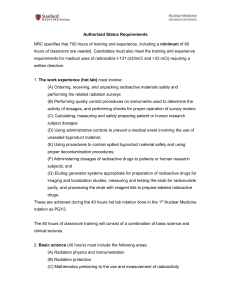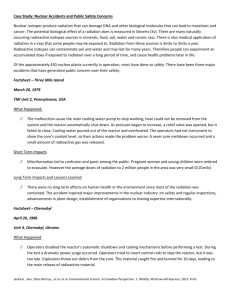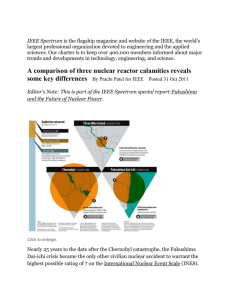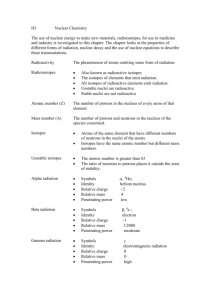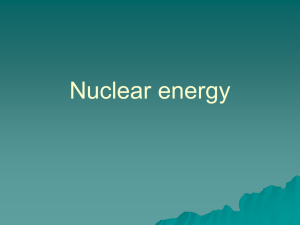paper
advertisement
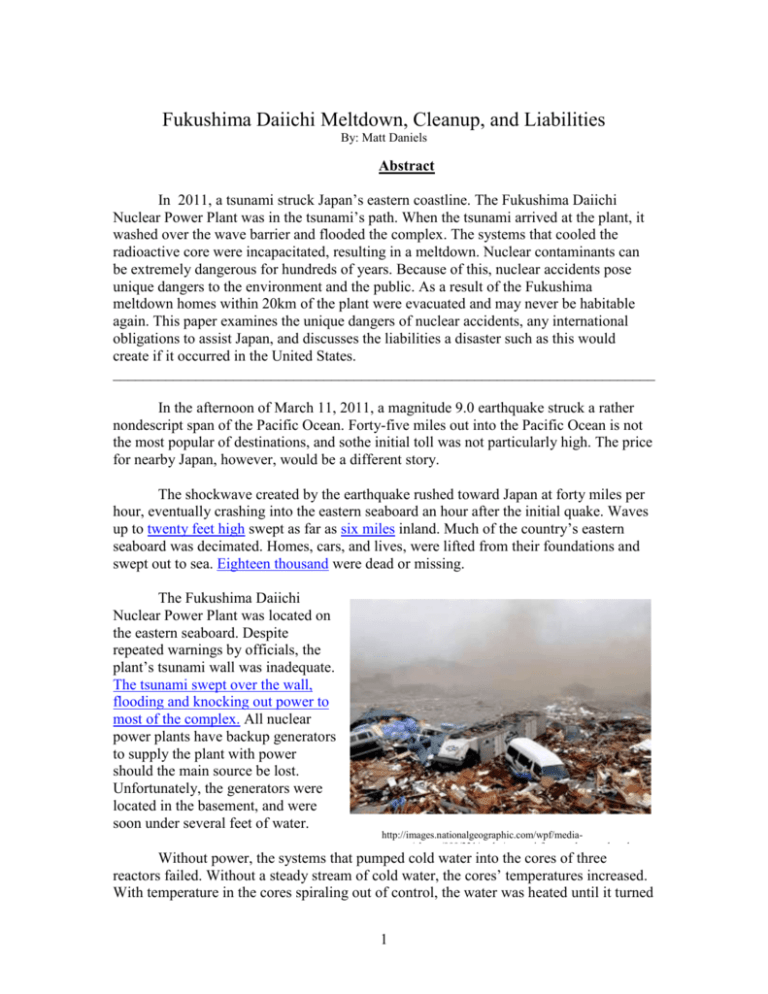
Fukushima Daiichi Meltdown, Cleanup, and Liabilities By: Matt Daniels Abstract In 2011, a tsunami struck Japan’s eastern coastline. The Fukushima Daiichi Nuclear Power Plant was in the tsunami’s path. When the tsunami arrived at the plant, it washed over the wave barrier and flooded the complex. The systems that cooled the radioactive core were incapacitated, resulting in a meltdown. Nuclear contaminants can be extremely dangerous for hundreds of years. Because of this, nuclear accidents pose unique dangers to the environment and the public. As a result of the Fukushima meltdown homes within 20km of the plant were evacuated and may never be habitable again. This paper examines the unique dangers of nuclear accidents, any international obligations to assist Japan, and discusses the liabilities a disaster such as this would create if it occurred in the United States. ________________________________________________________________________ In the afternoon of March 11, 2011, a magnitude 9.0 earthquake struck a rather nondescript span of the Pacific Ocean. Forty-five miles out into the Pacific Ocean is not the most popular of destinations, and sothe initial toll was not particularly high. The price for nearby Japan, however, would be a different story. The shockwave created by the earthquake rushed toward Japan at forty miles per hour, eventually crashing into the eastern seaboard an hour after the initial quake. Waves up to twenty feet high swept as far as six miles inland. Much of the country’s eastern seaboard was decimated. Homes, cars, and lives, were lifted from their foundations and swept out to sea. Eighteen thousand were dead or missing. The Fukushima Daiichi Nuclear Power Plant was located on the eastern seaboard. Despite repeated warnings by officials, the plant’s tsunami wall was inadequate. The tsunami swept over the wall, flooding and knocking out power to most of the complex. All nuclear power plants have backup generators to supply the plant with power should the main source be lost. Unfortunately, the generators were located in the basement, and were soon under several feet of water. http://images.nationalgeographic.com/wpf/mediacontent/photos/000/331/cache/tsunami-facts-update-earthquakejapan_33135_990x742.jpg pumped cold water into the cores of three Without power, the systems that reactors failed. Without a steady stream of cold water, the cores’ temperatures increased. With temperature in the cores spiraling out of control, the water was heated until it turned 1 to steam and the cores became so hot they literally melted. As the heat increased, so did the pressure. Despite several attempts to vent this pressure, the protective containments around the cores exploded, ejecting radioactive material into the surrounding area. Nuclear disasters pose a distinct threat. The object of this paper shall be to discuss the state of the cleanup effort at Fukushima, any obligations the international community has to assist in this cleanup, and to analyze the liabilities created should an analogous disaster occur in the United States. I. The Cleanup Effort Nuclear contamination is a unique problem for many reasons. First, each atom of radioactive material is capable of emitting radiation. Radiation is a particle emitted from an atom, and this radiation can be harmful a person in a plethora of ways. Thus, each atom of radioactive material can potentially harm someone. Radiation comes in a myriad of forms. For our purposes, there are three categories of radioactive materials: gamma emitters, beta emitters, and alpha emitters. Gamma rays, the radiation emitted by the most dangerous radioactive compounds, are photons, highenergy particles of light. Gamma rays can make their way through variety of materials, including the protective layer of a human’s skin and flesh. There, they can damage people’s cells and DNA. Beta particles, on the other hand, are electrons. These electrons can worm their way into the human body, but cannot penetrate as deeply or through many materials as gamma rays. Alpha particles are considered the least harmful type of radiation. An alpha particle is a helium nucleus (two protons and two neutrons). Since the particle is so large it cannot penetrate many materials, and thus our skin protects us from them. However, if an alpha-emitting compound is eaten or inhaled it can cause damage to the cells within the body. These types of radiation damage our cells by their tendency to ionize atoms. (See also, Ionizing Radiation.) When one of these particles is emitted and interacts with an atom in our body, it can do one of three things. Gamma rays tend to knock electrons off of atoms; beta rays add an electron to the atom; and alpha particles strip electrons off atoms. This ionization fundamentally changes how atoms behave. Our biochemistry is so finely tuned, that when atoms do not behave as they are supposed to, biological processes cease to function properly. Thus, ionizing radiation is quite harmful to us. If a person receives a large enough dose of ionizing radiation, it can interfere with their biochemistry, leading to potentially fatal radiation poisoning. If enough radiation is received over time, it can alter the structure of a cell’s DNA, eventually causing cancer. Therefore, radioactive materials can be extremely dangerous. The problem at Fukushima is, in the simplest sense, keeping the radioactive material within the plant contained there. Once these radioactive materials are released into the environment, they 2 can be eaten or absorbed by animals and plants. Once those organisms have absorbed the radioactive material, it is then incorporated into their bodies, paving the way for humans to similarly absorb it. The real issue with radiation is not simply that human beings might be exposed to it. The average American receives a dose of radiation every day. Residents in Denver receive almost twice the dose of the average American. Brief exposure to radiation is not very harmful, provided that the dose is low. The true harm presented is the possibility that these radioactive materials could be absorbed and incorporated into one’s body, where they may emit radiation until they decay. Persistent exposure to significant amounts of radiation is dangerous (See also, Strontium). Mere exposure to radiation, however, happens on a daily basis. Indeed, the iconic radiation suits do very little to mitigate radiation. Their actual purpose is to protect the wearer from getting radioactive materials on or in themselves. Consider what would happen if someone were to take a piece of radioactive material, seal it in plastic so that the material itself was contained, but would still emit radiation. The material is then placed in a room full of law students. In all likelihood, panic would ensue. However the remedy to this situation is to simply exit the room. As long as one does not linger around ionizing radiation, the risk of receiving a harmful dose in such short a time is low. Now, let us say that the piece of radioactive material is ground to dust and poured into the middle of that same room of law students. Now this is more of a problem. Not only is the material not in plastic, it is ground into dust. Try as one may, they would never be able to remove the dust from the carpet entirely. If the material was vacuumed it up, it would simply disburse into the vacuum. The vacuum may even fling some of the material into the air, where the students could aspirate it or swallow it. Once the material has been incorporated into your body, you cannot get away from it – the radioactive material is coming with you. Since you cannot simply remove yourself from the material, as in the first example, the total dose of radiation you receive from the material increases many times over. This is the problem facing the cleanup efforts at Fukushima. When the reactors exploded, they flung radioactive contaminants over a 30-kilometer radius around the plant. The term radioactive material literally means just that - Dust, particles and tangible pieces of radioactive material. If you were required to go outside right now, and pick up every single piece of Cesium you could find in the dirt, how likely would you be to complete that task? It is simply physically impossible to completely clean up a radioactive disaster such as the one at Fukushima Daiichi. In this context, a “clean up” is at best an ameliorative goal, unlikely to ever be reached. 3 Element Cesium-137 Iodine-131 Strontium-90 Emission Beta Gamma Beta Half-life 30.17 +/- .03 years 8.0197 days 28.79 years Within the core of a nuclear power plant, lies as much as 90 tons of a radioactive isotope of Uranium. The individual atoms of the uranium isotope (U-235) are split. This splitting releases heat that is used to generate steam, which is then used to spin turbines and generate electricity. This nuclear fission produces two elements with a smaller atomic number, which are usually also radioactive. Among the most dangerous of these materials are Cesium-137, Iodine-131, and Strontium-90. The human body stores trace amounts of Cesium; we readily absorb and assimilate Cesium into our musculature. Unfortunately for us, our bodies do not distinguish between the nonradioactive Cesium, and the radioactive Cesium-137. To make matters worse, Cesium is an alkali metal, which means it easily reacts with water to form a salt, which is in turn easily dissolved in water. This solubility makes Cesium hard to contain in places like Fukushima where there are heavy rains and subterranean water flows. Therefore, Cesium-137 is a particularly dangerous radioactive isotope because of its difficulty to contain, and ready absorbability by the human body. Iodine-131 is a gamma emitter, which as mentioned previously, is considered one of the most damaging types of radiation. Iodine is readily absorbed by the thyroid gland, where radioactive isotopes of the element can decay and cause thyroid cancer. Strontium-90 is chemically similar to calcium. Therefore, our bodies deposit it into our bones, where it can decay and cause bone cancer such as leukemia. Children who were born in the 1950’s-1960 actually have more radioactive strontium in their bones because of widespread nuclear testing during this period. These compounds are just a few of the many radioactive isotopes present in the core of a nuclear reactor. If enough these materials are disbursed into an area, it may never be habitable again. http://online.wsj.com/news/articles/SB10000872396390 444772404577589270444059332 That being said, the estimates of radioactive material released by the 4 Fukushima disaster are far from the apocalyptic amounts many suggest. Dr. Richard Muller, a physicist at the University of Berkley, estimated that the total deaths caused by the radioactive material from the Fukushima plant will be 1,500 deaths over the next seventy years. (See, linear hypothesis of radiation exposure). Considering that the tsunami killed 18,000, and that about 1,500 people die in car crashes every two weeks in the United States alone, 1,500 deaths is a relatively small number. The cleanup effort at Fukushima aims to keep this number as low as it is, but it is treacherous work. A nuclear meltdown is aptly named – the radioactive core of the reactor becomes so hot it literally melts. This radioactive material is difficult to contain when it’s molten. It can melt through its protective casings and seep into the ground, polluting the nearby area with radioactive contaminants. Further, with the temperature of the molten core reaching at least 1,132 degrees Celsius, there would simply be no way that the molten material could ever be removed from the site. Therefore water must be pumped into the site to keep the core in its solid state so that it may be scooped into protective containers and removed. At Fukushima, about 400 tons of water is pumped into the ruined reactors every day. This water comes into direct contact with the radioactive cores, picking up and dissolving radioactive sediment. Some of the water gave radiation readings of 1000 millisieverts per hour, a dose that would probably give a person radiation sickness. For context, Nuclear workers are permitted to exposure to 20 millisieverts per year. Needless to say, this amount of highly radioactive water cannot simply be discharged into the environment. It must be stored, and eventually filtered before it can be released into the http://fukushimaupdate.com/can-an-ice-wall-stop-radioactive-waterleaks-from-fukushima/ ocean. Subterranean groundwater also presents a problem. Radioactive materials have leached into the ground under the plant. From here, the radioactive material can make its way to the water table, and then into the Pacific Ocean. To address this, the Japanese government has commissioned an apparatus that will create an underground wall of ice to surround the ruins of the reactors. The ice wall, to measure one hundred feet deep, will hopefully prevent subterranean water from flowing through the area, thereby alleviating the risk of it carrying radioactive materials into the ocean. Though other ice walls such as this have been created, this will be the largest system of its kind. Some are skeptical that 5 this system will work at all, but smaller, similar, systems have successfully prevented radiation leaks in the United States. It is estimated to cost around $400 million. Yet another formidable task is removing the radioactive fuel still in the reactors to a safe location. Removal of the nuclear fuel from one of the reactors began on November 18. With Reactor Three alone containing 90 tons of nuclear fuel, the task is daunting to say the least. If the rods break or overheat it could initiate a self-sustained nuclear reaction, causing another meltdown. There is 1760 tons of fuel stored at the plant; Chernobyl only stored 180 tons. All in all, the cleanup is estimated to cost a staggering $10 billion. The Tokyo Electric Power Company (TEPCO) is responsible for the clean up. As the owner of the Fukushima plant, TEPCO is strictly and exclusively liable for damages resulting from nuclear damage pursuant to Japanese law. Nuclear power plant operators are required to financially secure their liability up to $1.57 billion. If nuclear damage exceeds this amount, the Japanese government may help the operator compensate the damage. The Japanese Ministry for Education, Culture, Sport, Science and Technology (MEXT) establishes a reconciliation committee which victims of the nuclear damage may bring their claims to. The public has a three-year statute of limitation for them to bring their claim. National and Third Party Liability Legislation Nuclear power plant operator subject to strict, unlimited liability and required to financially secure JPY 120 billion ($1.57 billion) per site. Can be completed by government funds if approved. Amount paid by the government to TEPCO: JPY 120 billion ($1.57 billion). Amount received by TEPCO from the Nuclear Damage Compensation Facilitation Corporation: JPY 558.7 billion ($5.35 billion)* Estimated provisional compensation paid thus far: -JPY 52 billion ($.68 billion) to households*; -JPY 43 billion ($.55 billion) to individuals for evacuation fees*; -JPY 63 billion (.82 billion) to farmers, fishermen, and small-medium sized companies* Indemnity Agreement Nuclear Damage Compensation Facilitation Corporation TEPCO Adapted from a table made by Ms. Ximena Vasquez-Maignan, senior legal advisor for NEA. * as of 2011 6 II. International Obligations While there are numerous reasons that the international community should assist the Japanese in the cleanup, there is nothing that would obligate it to do so. Several international conventions could have come into play in the Fukushima cleanup. These are the Convention on Third Party Liability in the Field of Nuclear Energy (the Paris Convention), the Convention on Civil Liability for Nuclear Damage (the Vienna Convention), and the Convention on Supplementary Compensation for Nuclear Damage (CSCND). Japan has signed none of them. These treaties all provide a framework for countries affected by nuclear disasters to receive funds assisting with the cleanup. There is, however, a cost. The treaties stipulate that the operator of the plant where the disaster occurred will be held solely liable for any damages caused by the disaster, and that all other parties shall be indemnified. In early November, U.S. Energy Secretary Ernest Moniz urged the Japanese to sign the CSCND. The treaty requires five signatories to ratify it to bring it into force, and Japan would be the fifth. Many nations are skeptical of a treaty that would place sole liability on a domestic operator, regardless of any other (and probably foreign) party’s potential negligence. As discussed previously, TEPCO is already held exclusively and strictly liable for the disaster to Japanese citizens. Should TEPCO be held solely liable for the damages to the rest of the world, it Pictured: Japanese Prime Minister, Shinzo Abe. http://www.topnews.in/files/Shinzo-Abe_16.jpg would likely mean the end of the company. The Japanese government has already bailed out TEPCO once. Without TEPCO, who will finish the clean up? On the other hand, there is no guarantee that TEPCO will survive even without the treaty. By signing the treaty, Japan would at least receive some monetary assistance from the international community. III. Domestic Hypothetical If an accident like Fukushima Daiichi meltdown occurred in the United States, things would be very different. The Price-Anderson Act was enacted into law on September 2, 1957. It effectively indemnifies owners of nuclear power plants from public liability for nuclear accidents. In exchange, the act creates an insurance pool of $11.975 billion. At its inception, the legislation encouraged investment in the private nuclear power industry. 7 Under the Price-Anderson act, each nuclear power plant operator pays a $375 million dollar premium in private insurance for each reactor site. If a nuclear disaster causes damage in excess of this amount each licensee shall be assessed a prorated amount of up to $111.6 million dollars, for a grand total of $11.6 billion. For damages that exceed this amount, congress may increase the amount covered by the licensees or may issue funds itself. The Price-Anderson insurance covers bodily injury, property damage, sickness, death, and reasonable living expenses resulting from a nuclear catastrophe. During the Three Mile Island accident, the fund disbursed money to evacuated families from the affected zone for living expenses and lost wages. The fund was later used to settle a class action suit for economic loss brought by residents who lived near the Three Mile Island plant. In addition to the Price-Anderson act, the Robert T. Stafford Disaster and Relief Fund provides assistance to state and local governments. The relief fund is designed to provide early assistance to those affected by national disasters. It enables states to pay 25% of the cost of temporary housing, repairs, temporary mortgage or rental payments and other "unmet needs" of disaster victims. The federal government pays the other 75%. From the perspective of the plant operators, the Japanese and American compensation schemes are markedly different. In the United States, the operators are indemnified, whereas in Japan operators are held solely and exclusively liable. Further, American operators collectively bear the entire brunt of a nuclear accident. The operators themselves insure up to $375 million, and if the damage exceeds that amount the rest pitch in. In Japan, the operator guarantees $1.57, a much larger premium, but is dependent upon the Japanese government to bail them out if the damage exceeds that amount. As previously noted, the aggregate estimated cost of the cleanup is $10 billion. Thus, assuming that the estimate is correct, the total insurance allotted by the PriceAnderson Act should cover the initial costs of a Fukushima-like disaster. However, this does not include future damages caused by the radioactive contaminants. A claim for property damages based on radioactive contaminants in the soil is relatively easy to prove with a Geiger counter. Causation for personal injury, however, is more complex. Claims brought for personal injury damages caused by radiation would face a host of causation problems. How would one determine whether the cancer they died from was the result of radioactive contaminants? With the exception of Strontium-90, the radioactive materials most readily absorbed by the body do not stick around in it. Unlike Mesothelioma, which can easily be linked to asbestos, many of the harms caused by radiation have a myriad of other causes. Thyroid cancer, while rare, may be untraceable to the Iodine-131 if the isotope has long since decayed. Cesium-137 is present in the body for only a few months before it is excreted. Further, radioactive Cesium may cause many forms of cancer, none of which are specifically traceable to Cesium-137. Plaintiffs will have a difficult time linking their harm to the meltdown. 8 Assuming the estimate made by Dr. Muller in this hypothetical,1,500 people would die from radiation exposure caused by the meltdown. To recover, these 1,500 people would have to face the causation hurdles mentioned above. There is no way to tell how much each individual case would settle for, but considering the causation challenges, it is likely that a good number of claims would be unsuccessful. For these reasons the United States is better equipped to handle a Fukushima-like meltdown. The operators of the plant would likely be held to $486 million, as opposed to TEPCO that paid $1.57 billion. Additionally, the United States would have fewer financial obligations than the Japanese government. Where the Japanese must pay $8.43 billion, the U.S. would only pay the amount in excess of the Price-Anderson insurance. There may not even be damages in excess of $11.975 billion. The only actor who would get the shorter end of this stick would be the other licensees, who would have to chip in $111.6 million. Then again, it is possible that the backlash against the nuclear industry after such an accident would be mitigated by a system like the Price-Anderson Act. IV. Conclusion The cost of the Fukushima disaster is immense. At $10 billion, the cleanup from this accident is staggering and Japan is largely without help. Had this occurred in the United States, the industry and government might be better prepared, but the damage would still be done. It is patently apparent that an accident on this scale exacts an enormous toll. Many homes around Fukushima will be uninhabitable for hundreds of years. An estimated 1,500 people will lose their lives, and thousands more had their lives ruined. However, we should not be so quick to discount nuclear power on account of one disaster. Nuclear power fills an important role in the larger energy scheme. For all its pitfalls, nuclear energy is among the cleanest in terms of greenhouse emissions. Gamma radiation might sound bad, but just wait until the ice caps melt. For all the money the Fukushima meltdown will cost, it is still a rectifiable problem. People can be mobilized, topsoil can be removed, and radioactive isotopes will eventually decay. The planet’s climate, however, may be another sort of problem entirely. Nuclear energy could be the only viable path to clean energy our species will have for centuries to come. They answer may not be making nuclear energy a thing of the past, but making it safer. 9


